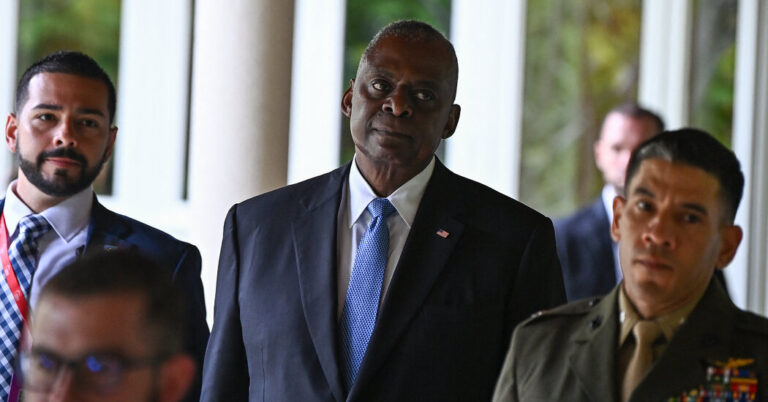U.S. Secretary of Defense Lloyd J. Austin and his Chinese counterpart met in person for the first time in 18 months on Friday to discuss trial steps to manage military tensions despite their opposing positions on Taiwan, the South China Sea and other disputes.
Austin’s 75-minute meeting with Chinese Navy Admiral Dong Jun in Singapore came after a flurry of senior Biden administration officials visited Beijing to discuss trade imbalances, U.S. restrictions on technology trade with China, China’s support for Russia during the war in Ukraine and other sources of tension.
President Biden has said the United States and China need to maintain high-level communication to avoid a potential crisis, but military issues remain the most difficult area of tension between the two countries, especially in the Pacific, where ships and military aircraft from both countries come into close proximity and where disagreements could escalate into conflict.
Austin and Admiral Dong discussed possible steps to prevent accidents or misunderstandings from escalating into conflict. Austin brought up an earlier proposal for a telephone conversation between Chinese and U.S. military commanders in the coming months and “welcomed plans to convene a Crisis Communications Working Group before the end of the year,” the Pentagon said in a statement about the meeting.
“Secretary Austin emphasized the importance of maintaining open lines of military-to-military communication between the United States and the People’s Republic of China,” the Pentagon said, referring to the People’s Republic of China.
Pentagon officials told reporters that Mr. Austin had suggested to Gen. Samuel J. Paparo Jr., commander of U.S. Indo-Pacific Command, that they hold a call with their Chinese counterparts. The U.S. and Chinese militaries established a crisis communications working group in 2020 to discuss ideas for defusing a potential conflict, but it has only met once.
Defense Ministry spokesman Senior Colonel Wu Qian said Admiral Dong and Austin “agreed to have more contact and exchanges at the next stage,” but Wu was more cautious about timing of calls between the commanders or meetings of the new crisis communications group.
When asked about the phone call, he said, “Relevant departments of both militaries are coordinating and in contact with each other.”
Fears that a military standoff between China and the United States and incidents at sea could escalate into a crisis have their roots in long-standing disputes that are not easily resolved. They include China’s claims to Taiwan, an island democracy that relies on the United States for its security, and Beijing’s increasingly assertive claims to large swaths of the South China Sea that have alarmed its neighbors.
Pentagon officials have also warned that People’s Liberation Army military aircraft and warships have become increasingly aggressive and reckless, shadowing and harassing Chinese and allied ships and aircraft near China’s waters to gather intelligence.
Austin questioned Admiral Tung about Chinese military activity near Taiwan and indicated that the United States would continue to send warships and aircraft into international airspace and waters near China, despite frequent disruptions by the Chinese military.
“The Secretary of Defense made it clear that the United States will continue to fly, navigate, and operate safely and responsibly where permitted under international law,” a Pentagon summary of the meeting said.
But Beijing rejects the idea that other countries have the right to operate military aircraft and warships near China’s coast. In Chinese officials’ view, agreeing to stricter rules on encounters between military aircraft and ships would simply give U.S. forces more authority to approach China’s coasts and gather useful images and signals.
“China believes that just because you can navigate doesn’t mean you can run wild,” Wu told reporters. “We believe security is mutual, and that one side does not gain absolute security at the expense of the other.”
For more than two years, the Pentagon has focused on supporting Ukraine and containing risks in the Middle East while Israel fights Hamas, but China’s military buildup remains a “pacing challenge” in the eyes of Pentagon planners, a long-term seismic shift that, if poorly managed, could drag the U.S. into war with another nuclear power.
The United States has by far the world’s largest military, and its Pentagon budget is still roughly three times China’s annual military spending, according to the Stockholm International Peace Research Institute.
But Beijing does not have the global engagement or operations of the U.S. military and is particularly focused on projecting power in Asia, where it has territorial disputes with neighbors from Japan to Indonesia, and across the ocean.
Dong took over as defense minister late last year following the sudden disappearance of his predecessor, who was apparently embroiled in a widening investigation into corruption and other wrongdoings in the People’s Liberation Army. He is not seen as having the authority to make major strategic decisions.
“He’s not a member of the Central Military Commission, much less the Politburo,” Drew Thompson, a visiting senior fellow at the Lee Kuan Yew School of Public Policy at the National University of Singapore, said of the Communist Party’s two most powerful figures.
“This is an opportunity for both sides to exchange established talking points,” said Thompson, a former Pentagon official who negotiated with the Chinese military.
Dong’s predecessor, General Li Shangfu, is under U.S. sanctions and declined to meet with Austin in Singapore last year. Austin and Dong met via video call in April. Austin last met in person with a Chinese defence minister in November 2022, when he met with General Wei Fenghe in Cambodia.
Colonel Wu summed up the recent meeting with a familiar refrain: “Meeting and talking is better than not meeting.”

